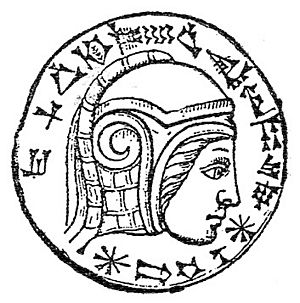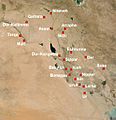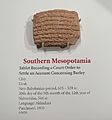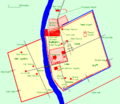Neo-Babylonian Empire facts for kids
The Neo-Babylonian Empire was a powerful kingdom in ancient Mesopotamia. It is also sometimes called Chaldea. This empire was part of the long history of Babylonia, and it was ruled by a group of kings known as the 11th, or Chaldean, dynasty.
Contents
A New Beginning for Babylonia
The Neo-Babylonian Empire existed from 626 BC to 539 BC. It began when a leader named Nabopolassar led a rebellion against the powerful Assyrian Empire. Before this, Assyria had controlled Babylonia for a long time. Nabopolassar successfully broke free and became the first king of this new Babylonian empire.
Famous Kings and Their Reigns
One of the most famous kings of the Neo-Babylonian Empire was Nebuchadnezzar II. He ruled for a long time, from 605 BC to 562 BC. During his reign, the empire became very strong and built many impressive structures, including the famous Ishtar Gate and the Etemenanki ziggurat, which some believe was the real "Tower of Babel".
What Was Chaldea?
The term "Chaldea" originally referred to the southern part of Babylonia. This area was home to a group of people called the Chaldeans. Over time, as Chaldean leaders became kings of Babylon, the entire empire sometimes became known as Chaldea.
The End of an Empire
The Neo-Babylonian Empire came to an end in 539 BC. This happened when Cyrus the Great, the king of the Persian Empire, captured the city of Babylon. This event marked the end of Babylonia as an independent kingdom.
Images for kids
-
Map of the Old Babylonian Empire under Hammurabi (r.c. 1792–1750 BC).
-
Locations of some major Mesopotamian cities.
-
The so-called "Tower of Babel stele", depicting Nebuchadnezzar II in the top-right and featuring a depiction of Babylon's great ziggurat (the Etemenanki) to his left.
-
Illustration of the inhabitants of Babylon deriding the Achaemenid king Darius I during the revolt of Nebuchadnezzar III in 522 BC. From the History of Darius the Great (1900) by Jacob Abbott.
-
Major cities of Lower Mesopotamia in the 1st century BC.
-
9th century BC depiction from a cylinder seal of the Statue of Marduk, Babylon's patron deity Marduk's main cult image in the city.
-
Cylinder by Nabonidus, commemorating restoration work done on a temple dedicated to the god Sîn in Ur. Exhibited at the British Museum.
-
Tablet concerning a legal dispute over barley, from Uruk and dated to the reign of Nabonidus (544 BC). Exhibited at the Oriental Institute of the University of Chicago.
-
Tablet containing a 6th-century BC Babylonian "map of the world", featuring Babylon at its center. Exhibited at the British Museum.
-
Tablet recording a silver payment from the temple dedicated to the god Shamash in Sippar, written during the reign of Nebuchadnezzar II. Exhibited at the Metropolitan Museum of Art
-
The Ishtar Gate, one of Babylon's eight inner city gates, was constructed by King Nebuchadnezzar II c. 575 BC. The reconstructed gate is exhibited at the Pergamon Museum in Berlin.
-
City plan of Babylon, showcasing the locations of major points of interest. The outer walls and the northern Summer Palace are not shown.
-
Mud-brick from the Processional Street of Babylon stamped with the name of Nebuchadnezzar II.
See also
 In Spanish: Imperio neobabilónico para niños
In Spanish: Imperio neobabilónico para niños



















